
Renovating the chicken pasture
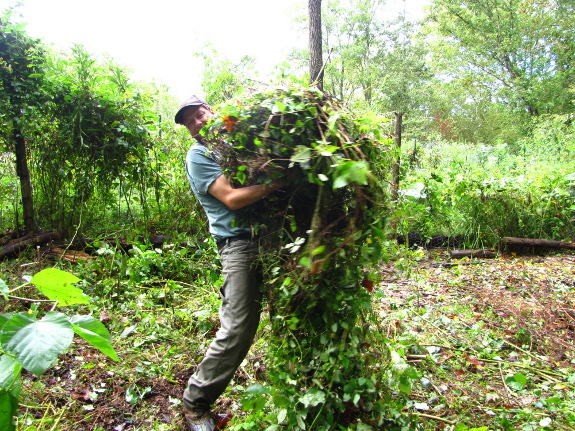
I begged for drought to
slow the spread of blight on our tomatoes, and the weather
complied...for a while. You can only hold back our rain so long,
though, before the 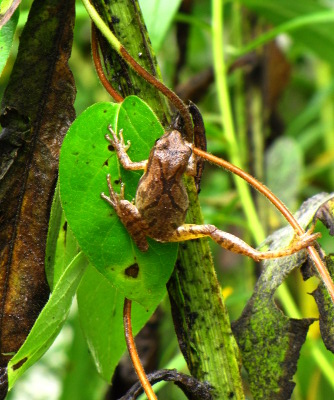 weather
gods rebel and drop six inches of water on you in one fell swoop.
The creek rose, the jewelweed revived, and the parched earth in the
chicken pastures gave a sigh of relief. Time to change our plans
and renovate the forest
pasture now instead
of later.
weather
gods rebel and drop six inches of water on you in one fell swoop.
The creek rose, the jewelweed revived, and the parched earth in the
chicken pastures gave a sigh of relief. Time to change our plans
and renovate the forest
pasture now instead
of later.
The forest pasture was
chock full of life, but it was all out of reach of our chickens.
Despite being birds, chickens don't really fly, and once the weeds get
more than a couple of feet tall, the flock might as well be foraging in
a desert. The ninja
blade, the chainsaw,
and brute strength served to whack down the weeds, root out the logs,
and move all of the biomass to the edges of the pasture.
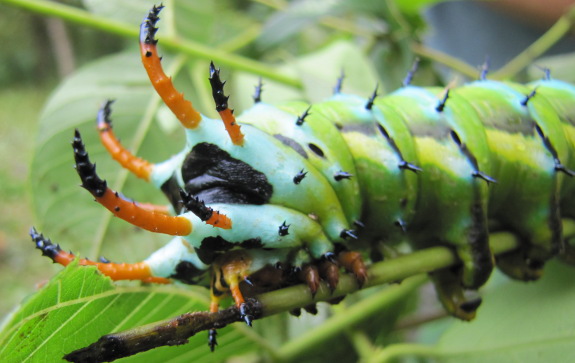
 In the process, we were
treated to some magnificent finds, like the chorus frog pictured
earlier and the hickory horned devil shown here. I'll bet you've
never seen a caterpillar this big and scary --- I hadn't. This
guy will turn into a regal moth --- the heaviest moth north of Mexico
--- and despite its spines, the caterpillar won't sting.
In the process, we were
treated to some magnificent finds, like the chorus frog pictured
earlier and the hickory horned devil shown here. I'll bet you've
never seen a caterpillar this big and scary --- I hadn't. This
guy will turn into a regal moth --- the heaviest moth north of Mexico
--- and despite its spines, the caterpillar won't sting.
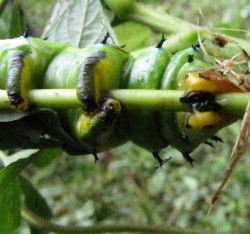
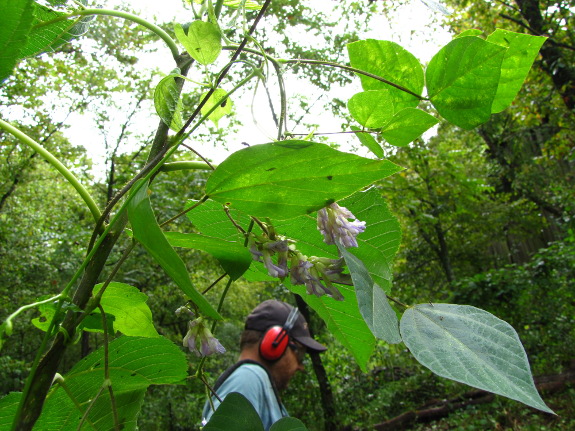
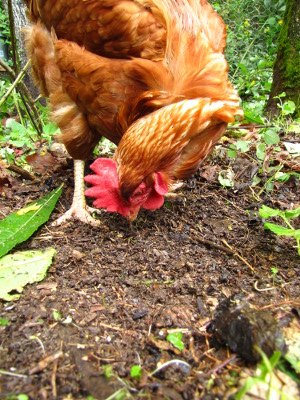 We planted an everbearing
mulberry in this pasture in the spring, but I haven't even been able to
see the tree for months due to the smothering action of Japanese
honeysuckle, hog-peanuts, and virgin's bower. Imagine my surprise
to discover that the mulberry was vine-wrapped but thriving, having
doubled in height already. Maybe our chickens will be treated to
summer fruits sooner rather than later.
We planted an everbearing
mulberry in this pasture in the spring, but I haven't even been able to
see the tree for months due to the smothering action of Japanese
honeysuckle, hog-peanuts, and virgin's bower. Imagine my surprise
to discover that the mulberry was vine-wrapped but thriving, having
doubled in height already. Maybe our chickens will be treated to
summer fruits sooner rather than later.
I'll be planting annuals
for winter forage (probably rye, oats, Austrian winter peas, and
oilseed radish) while the ground's still damp, but first I wanted to
give our chickens an opportunity to scratch the earth up a bit
first. Good thing we have such a large flock momentarily --- 19
near adult chickens, 8 of whom will go in the freezer this week.
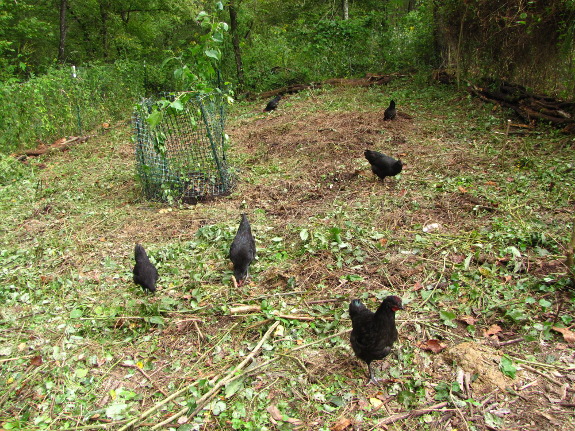
Turning them onto such a
bare pasture makes it much easier to see the behavioral differences
between our various types of chickens. The Golden Comets
were the first to find the new pasture (a process that involves going
into the coop and then out a newly opened pophole), eventually followed
by just about everyone else. The White Cochin
and one Cuckoo
Marans just couldn't figure it out --- they stood forlornly on the
other side of the dividing fence, watching their buddies eat the
insects knocked loose during our clearing spree.
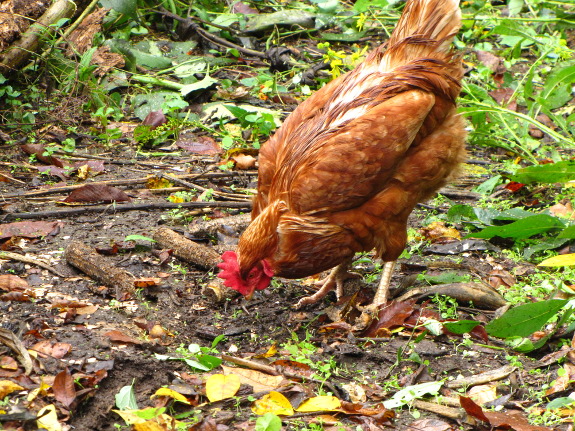
The Black
Australorps wandered around pecking for insects, but the Golden
Comets thought it was a better idea to stay in one place and scratch up
bugs. I got down close and was surprised to see that every swipe
of this old hen's foot turned up something edible --- little
earthworms, centipedes, and snails. The number of invertebrates
she consumed in such a short time was amazing.
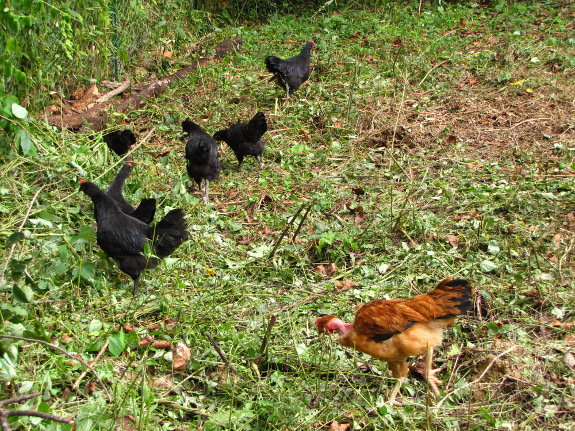
For more on the larger
picture of chicken pasturing (and my evolving plans for our pastures),
be sure to subscribe to our chicken blog. As you probably
figured out, this post is really just about pretty pictures.
Want more in-depth information? Browse through our books.
Or explore more posts by date or by subject.
About us: Anna Hess and Mark Hamilton spent over a decade living self-sufficiently in the mountains of Virginia before moving north to start over from scratch in the foothills of Ohio. They've experimented with permaculture, no-till gardening, trailersteading, home-based microbusinesses and much more, writing about their adventures in both blogs and books.
Want to be notified when new comments are posted on this page? Click on the RSS button after you add a comment to subscribe to the comment feed, or simply check the box beside "email replies to me" while writing your comment.

We had to do this for our goats this year after they ate the low tree branches. It seems like you two are always doing stuff we are doing, only on the other side of the country.
Your blog is a lot of fun for us, thank you for sharing.
John & Jin